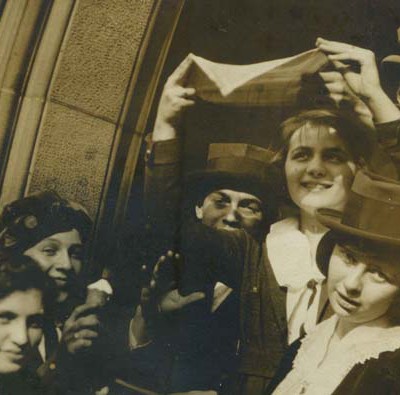
Morris and Jennie Barsky immigrated to Pittsburgh from Russia about 1907 with their young daughters, Belle and Sibyl (born Sadye). Morris had been a highly regarded cabinetmaker in Russia. Once here, they had five more children, Frances, William, Saul, Sam, and Sidney. The family lived in the Hill District before moving to Squirrel Hill.
Within two months in 1926, Morris, Jennie and Frances Barsky died in separate incidents, leaving Belle, 23, and Sybil, 21, to care for their four younger brothers. Despite these responsibilities, both women managed to launch successful careers in the arts.
Beginning with her roles in The Fortune Hunter and Officer 666 at Fifth Avenue High School, Belle Barsky was active in theater and music activities throughout her life. She regularly performed in productions at the Y Playhouse and contributed to efforts in the 1920s to legitimize the small theater company by including nationally known actors in its productions.
Belle trained as a pianist at the Pittsburgh Musical Institute and played at many social events in the Jewish community. She accompanied the Y Choral Society during its performances of Jewish folk music broadcasts on WWSW radio in the early 1930s. She also gave private lessons and taught music appreciation at the Council Lounge for Older People.
In 1934, Belle Barsky married Dr. Myer Rubenstein, a dermatologist. Sharing her enthusiasm for music, he played the French horn, violin, viola and cello. Belle and Myer Rubenstein were profiled, separately, in Ralph Lewando’s weekly “Who’s Who in Pittsburgh Music Circles” column in the Pittsburgh Press in 1953 and 1946.
Sibyl Barsky began her successful career as a sculptor in the early 1930s. Self-taught using household tools, she earned honors at Associated Artists of Pittsburgh exhibitions and praise from critics. Toward the end of the decade, she was one of six artists employed as part of the Pittsburgh group of the Federal Art Project, a program of the Works Progress Administration. Today, her works in clay, wood, stone and bronze are included in many collections, including a bust of Penn State University professor Fred Lewis Pattee in the foyer of the Pattee Library on the university campus.
For a time, she maintained a studio in the Blumcraft Company. Her bust of Blumcraft founder Hyman Blum is part of the permanent collection of the Heinz History Center.
In 1940, Sibyl Barsky married the poet Joseph Grucci. He taught at the University of Pittsburgh after serving in World War II. They then moved to Penn State University in 1950 where they made their home. Joseph Grucci published a long running poetry journal called “Pivot,” and wrote and translated poetry, including one of the earliest English versions of the Spanish poet Federico García Lorca.
William Barsky completed basic training in California in 1942 and joined the 804th Tank Destroyer Battalion as a radio operator. The battalion passed through North Africa in 1943 and headed north into Italy, where Barsky died in combat in April 1945.